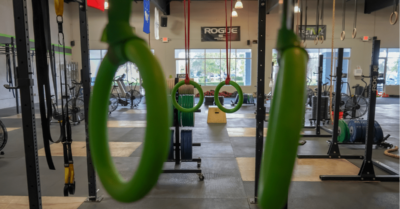Joe De Sena is a legend in the fitness world as the founder of the Spartan Race. Joe founded Spartan Race as a way to help regular people face up to adversity and overcome it. His philosophy on life is simple:
No adversity has been confronted and handled because everything came fast and easy. When adversity does arrive, and it always does, someone who has never encountered it before will have no clue what to do in response.
Adversity will come at you in life in many different shapes and forms. This is especially true for a fitness founder who is opening a fitness business for the first time. During year one, business gym owners face a mountain of challenges. As Mr. De Sena points out, if they haven’t experienced these types of problems before, they could struggle to overcome them.
The fitness industry has become hyper-competitive and becoming a successful gym owner is getting harder and harder. In fact, while there is massive potential in owning a fitness business, 8 out of 10 of them will fail in their first year. However, if you manage to clear the first-year hurdles, you will come out the other side a stronger person and better entrepreneur, way more able to handle whatever gym ownership throws at you.
Because we are heavily invested in the path our customers take from the minute we meet them, we have gained valuable insights into the common obstacles they encounter, especially in this crucial first year. From this, we have seen the lessons they have learned from these challenges.
So in this article, we will go through the 8 hard lessons you will learn from the first year of opening a fitness business and share with you the steps you need to take to make each challenge a little easier to overcome.
1. Pre-Sales Are Essential
The primary thing about starting up a fitness business is the cost. It is estimated that the average start-up cost of a gym is anywhere between $10,000 to $50,000 depending on the size of the gym. There are a couple of different ways of raising this kind of cash and whatever avenue you go down it’s vital you support it with a pre-sales strategy.
No matter what type of gym you are running the reality is that a lot more money is going out in comparison to what’s coming in with things like rent, electricity, equipment salaries, and insurance. Pre-selling memberships before the doors open can be a great way to cover these gym costs. It’s also the perfect way to kick off your marketing strategy and get your name out in the local community.
Here is a quick step-by-step guide to help you drive pre-sales before opening:
- Use your Facebook friend network to get the news out that you are opening a gym in the area and would like some feedback on your fitness business idea.
- Start a simple website page using the likes of WordPress, Wix, or Squarespace. On top of that start a Facebook and Instagram page.
- Put up flyers in the local area.
- Begin posting progress pictures and examples of the workouts you will be doing.
- Start a campaign for a registration day that introduces your gym to the local community and offers “early bird” style registration fee.
- Promote this campaign through a mixture of paid social media advertising, local media, and promotion through your existing Facebook friend network.
The 6 Crucial Steps to
Opening a Gym or
Studio
Discover more 2. You Aren’t Just a Trainer Anymore
Changing from being just a trainer to a gym owner is a massive leap. Even if you were in a more senior position previously, there was still the business owner above you whom the buck stopped with. Changing from the trainer mindset to the business owner mindset can be one of the hardest challenges to overcome.
And let’s be honest, no one gets into the gym business to do mind-numbing paperwork. However, the simple fact is that you need to be as comfortable behind a desk as you are in front of a class. A gym owner has to wear many hats in the beginning, from being the top salesperson to the head of marketing right through to being the janitor.
With a small business, the ability to transition seamlessly through various different roles is crucial to success. The best way to tackle this is by educating yourself on the different aspects of running a fitness business. Lucky for you we put together a guide to the essential resources you need to start up your own gym that is loaded with some fantastic information regardless of the type of gym you run.
Finally, the most important part is that you have to become a practitioner. Don’t waste time and a lot of money buying countless books and attending different conferences if you aren’t going to put what you have learned into practice.
3. Leads Won’t Appear Out of Thin Air
So after months of research, planning, and design, you have the perfect gym or studio that you wish was around when you were a regular gym goer.
People would be crazy not to show up to it, right?
The truth is that while you have boundless enthusiasm for your gym, the average person will see it as just another gym in the area. This is called the “build it, and they will come” mindset. You need to get out of that and into a “making it their only choice” mindset by throwing yourself into the trenches of marketing and lead generation.
The problem with a lot of first-time gym owners is that they see marketing as a campaign, an event, or a strategy. And because they think like that, it becomes something they dip in and out of, something that is given a lot of effort for a couple of weeks and then picked up again at another point down the line. However, this is the wrong way to think about things.
Marketing is not just a campaign, event, or strategy. Marketing is the continued implementation of all of these things and more so you constantly drive new leads and attract the right type of people to your fitness business.
Want to automate your entire marketing outreach program?
Meet Amplify
4. Follow up and Nurture or They Will Leave
A common problem that occurs with lead follow-up is that it is only done once, if at all. This is especially true in the first couple of months of a fitness business, where a million things are coming at you every day.
But here is the crucial thing about leads.
They are like gold dust and as a fitness business owner, you should treat them as your number one priority. If you do just follow up once with a lead, the chances are that they will be lost to another studio who are willing to put in the work that you aren’t.
It’s then vital for you to bring the person on the journey from an interested lead to an active and engaged member. Have a process in place where you follow up at least 10 times through calls or emails to give yourself the best chance of closing in on a new member.
The best way to nurture leads is through using either free or low-cost trials. The trial period gives you a chance to build a relationship with the prospective member. The advantage of using the inexpensive trial method is that you have their card details on file, which makes it easier to have the conversation about converting them to a full member.
If you feel like you’re failing at your marketing efforts, or that you need a boost to keep those leads coming in, we’re here to help you.
Get More Leads For Your Business
5. Create a Retention Strategy Early
When we wrote our article on the gym retention statistics you should focus on, one statistic, in particular, stood out.
It costs nine times as much to acquire new members as it does to retain existing ones.
This is not overly surprising considering the amount of marketing budget you will spend trying to acquire a new member. Retention is definitely crucial to the long-term success of your gym. However, you need to be clear about how you measure retention. It isn’t measured by the number of total members you keep. Members are always going to be canceling and switching to other gyms and studios. The crucial thing is how much they pay you before this happens.
So to keep this member paying as long as possible you need to make retention a priority for your fitness business. And, like the marketing side of the gym, you can’t just dip in and out of retention, it needs to be an ongoing process.
Four great ways to supercharge retention are:
- Build a community with events.
- Keep up regular communication with members to show you are interested in how they are doing.
- Track their progress so they can see that your studio is giving them the results they need.
- Run referral programs to gauge if members are willing to recommend friends. If they aren’t this is a huge opportunity to intervene and discover any underlying issues.
6. Develop More than One Revenue Stream
As we discussed in our blog on different practical product and service streams, gyms and fitness studios can’t really rely on revenue from memberships alone. It’s very common for a gym owner in their first year of business to just focus on acquisition.
While this is obviously key to the survival of your fitness business when it’s in its infancy, you should definitely develop at least one or two other revenue streams. Not only do they bring in that extra bit of revenue that could be crucial to your survival, but they also can help with your acquisition and retention strategies. The most successful businesses diversify into different revenue streams alongside raising revenue through core memberships.
The most practical revenue stream you can develop in the first year is events. The benefit of putting on events is that it gets your members out of the class environment and into a more relaxed setting. This enhances their member experience and works towards improving retention. When it comes to marketing the event can be a great way of showcasing your gym or studio to the general public. The revenue comes in from ticket sales and exposes your business to potential new prospects.
Never Miss a Member Payment Again
7. Make Playbooks for Everything
With owning a gym, there will be a great deal of throwing stuff at the wall and seeing what sticks. Too often though this experimentation is not recorded and it takes longer to develop a process that works for the key areas of your business.
The hectic nature of the first year means that there might not be a chance to step back and take a breath. By doing this though you can figure out what has been successful and what hasn’t. From that, you can develop shared-based practice across the business.
From things like your digital marketing strategy to how you organize and incentivize your staff, there needs to be a record of what works and what doesn’t. Think of the following examples:
- Did you run a successful Facebook Ad campaign that brought it a record number of leads?
- Are your consultations contributing to long-term member retention?
- Have you developed a sales pitch that is improving your number of sign-ups?
Take what is working well in each area of the business and develop a playbook. By developing a playbook, you will be able to provide a resource for staff training and implement a proven working strategy throughout your new gym.
The 6 Crucial Steps to
Opening a Gym or
Studio
Discover more 8. Reach Out and Build a Network
No person is an island, and it is foolish not to source outside opinions from those around you. And, while the advice of family and friends can be helpful, it is better to talk to people who have been there and done that. By building a network of mentors and collaborators that you trust, you can get ideas out of your head and bounce them off people with different perspectives.
You are probably thinking that building this type of network is easier said than done, but there are two simple ways of doing this:
- Contact owners of profitable gyms and studios outside your local area whom you are not in direct competition with. Ask them to do a short interview on the areas you feel you need help with most and try to see if you can help them with any advice of your own. Build the relationship from there.
- Get in touch with business owners outside the fitness industry to get an entirely different perspective on running a successful business. This may be precisely what you need to solve an issue. As well as that there is an opportunity to develop a potential business relationship for the future, especially if they are local.
Focus on Automation & Passive Income
The first year of running any small business is a steep learning curve, especially the first time of asking. There will be a lot of challenges and adversity along the way and moments where you feel like giving up. But if you take these lessons on board and anticipate what’s coming down the line, you will be in a better position to handle these challenges and will be better able to handle any adversity that pops up in the future.
If you’re looking for a fitness business platform that can not only help you save up to 20% on admin time, but also double your revenue in 18 months, then ABC Glofox is here for you.
If you’re ready to take the next step in your fitness business journey, speak to one of our fitness business experts today.














